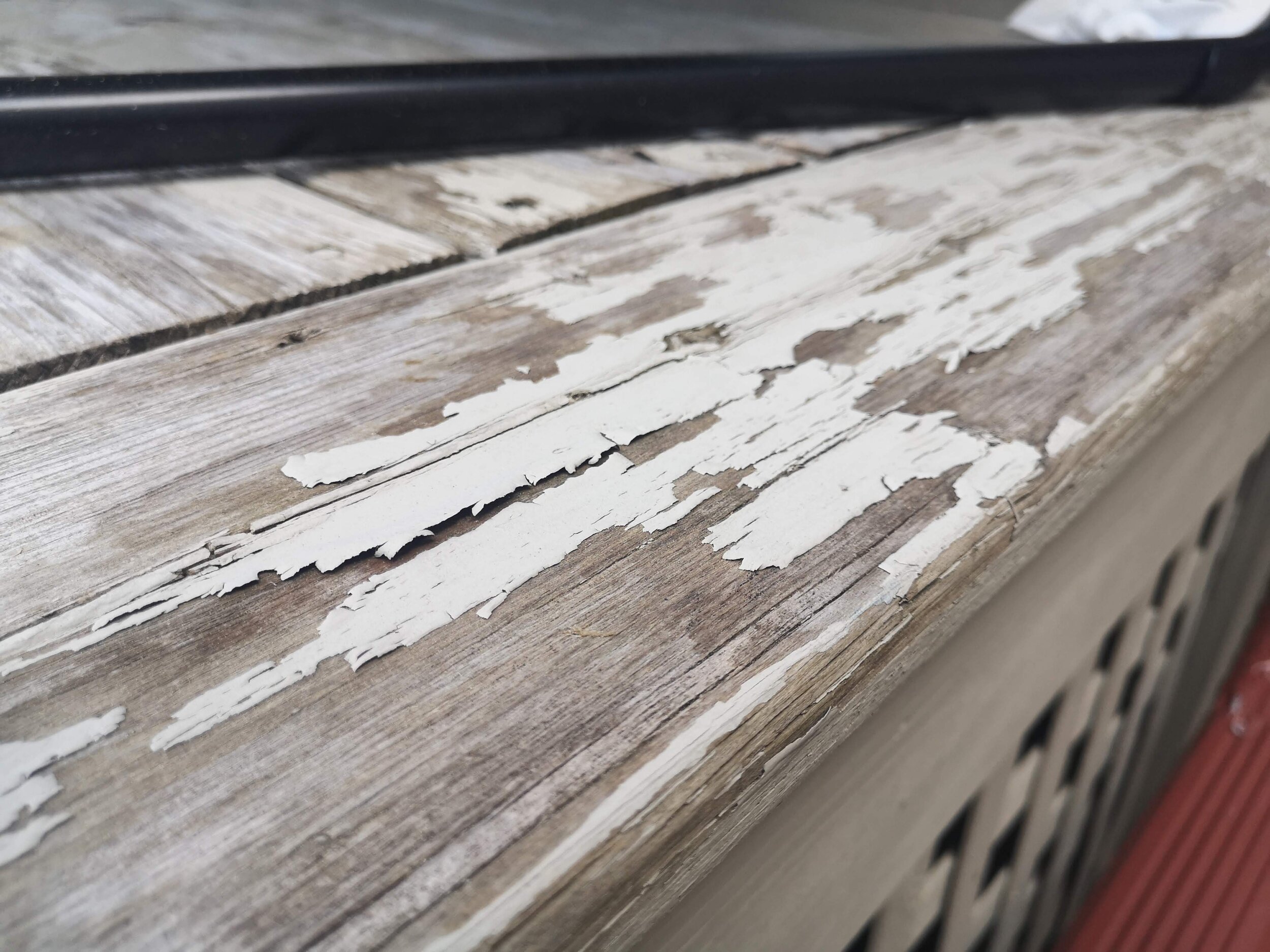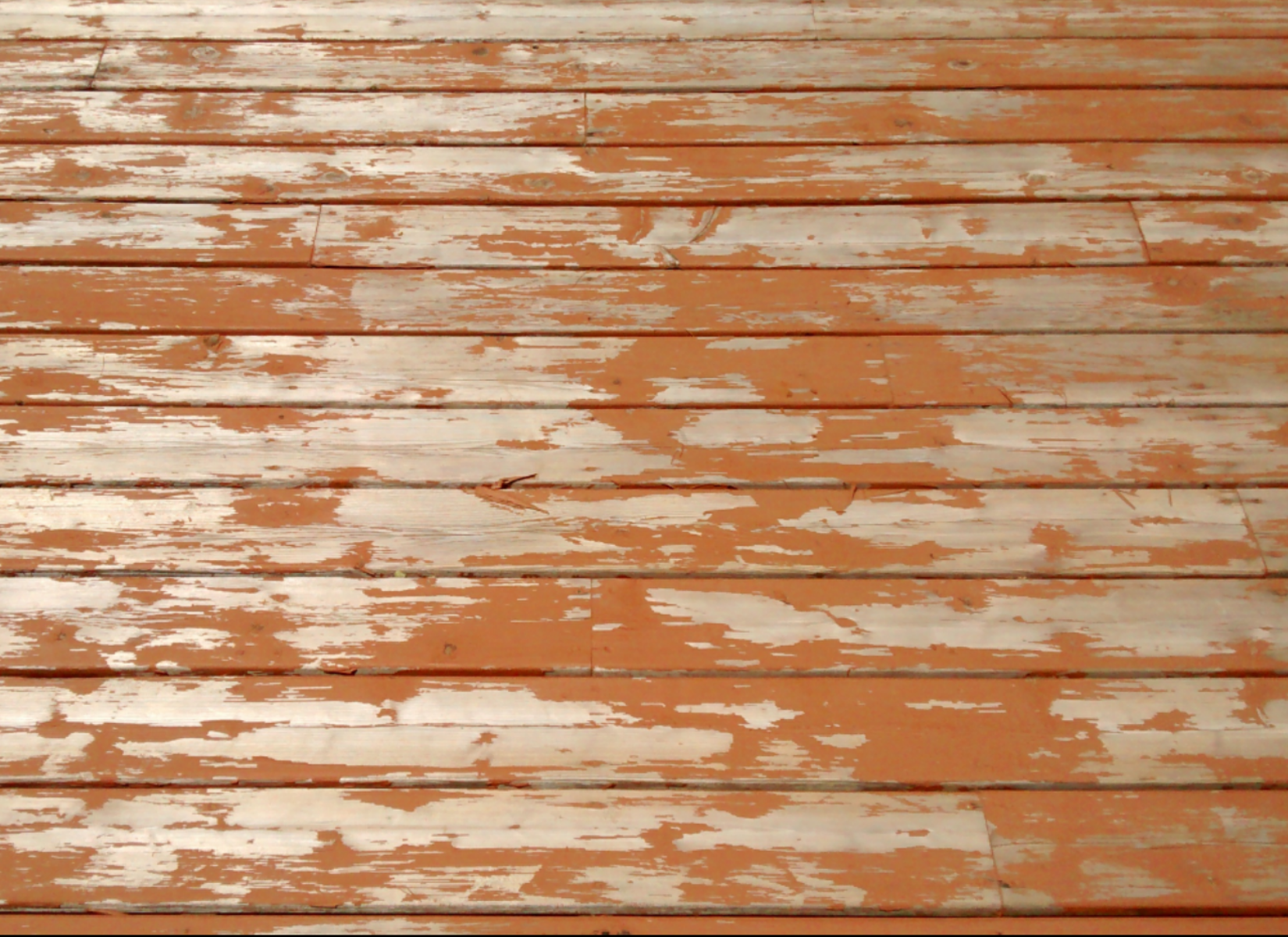Why Solid Stain / Paint Fail As Exterior Wood Coatings (And What To Do If Your Deck Has This Finish)
There is no question that solid stain is the absolute bane of everything we believe in at Sand & Stain. Our promise to you is captured right in our original tagline: ‘Never Peel Again’—and if there’s one thing we’re certain of, it’s that solid stain will peel in Canada, no matter who applies it.
Why Solid Stains Fail
Probably the biggest reason solid stain fails, is because it acts much like a paint opposed to a stain. Paint protects by forming an outer film coating and is built up with layers and is far too thick to ever penetrate the wood. That’s why when you see solid stains or paint on exterior wood like a deck or fence, it peels off in pieces / chunks and leaves completely bare wood behind.
I’m surprised solid stain is even classified as a stain—it really should be called a paint, because it basically is no different than a can of flat sheen exterior water based paint. Sometimes people ask why we don’t restore decks, fence, and siding projects with solid stain and paint anymore, and there are many reasons for that:
it’s impossible for sanders to get everything off from in between the boards, in the deeper cracks, etc.
it takes 2-3 times as long and will never return to our standards
we don’t believe in chemical strippers and toxic solutions to remove products that shouldn’t be used in the first place
there are more than enough cedar and premium or specialty woods like Ipe out there for us to restore and maintain
Why Penetrating Oil Stains Work
A true stain is the opposite of solid / opaque stain or paint. It is designed to penetrate into the pores of the wood and protect from the inside outwards. There is absolutely no layer on top of the wood, and therefore nothing to blister, crack, peel, bubble, etc. (And if it’s not obvious, just because the can says the word “penetrating” does not mean it does…)
Penetrating stain wears over time from fading versus peeling, but can be easily reapplied as opposed to stacking more layers of solid stain that will inevitably peel, or having to remove old peeling layers of solid stain each year and starting over again.
To learn more about how to prep, finish, and maintain a deck so it never peels, check out our flagship Sand & Stain System here.
What To Do If Your Deck Is Coated With Solid Stain
There’s many reasons a deck may have ended up with solid stain or paint. Here’s a few of the most common ones we see everyday:
you bought a house and inherited a deck with solid stain already on it
you were recommended solid stain from the local box store and had no reason to question it
you let your deck go gray and figured covering it all up with solid stain seemed like the simplest solution
Ultimately, it doesn’t matter how your deck got coated in solid stain. If you’ve read this far, your deck is likely covered in a peeling mess of half solid stain and half unprotected graying bare wood that looks like the map of Europe and you’re wondering what your options are.
These are the 3 options I present to people in this exact position on a daily basis in order of least expensive to most expensive:
1) Continue With Solid Stain
Pardon my blunt honesty, but it only takes one application of solid stain to “ruin” your exterior wood project. If you’re alright with the idea of treating your deck like an old house with peeling paint, you can remove any loose finish, sand the edges down the best you can, and reapply more solid stain hoping that somehow it will last longer this time around before peeling.
Realistically, you’ll notice it peeling right after the winter snow melts away— perhaps sooner, and this is going to be a yearly project that never goes away.
If it’s a fence or vertical surface, it will last longer but start peeling at the bottom 3-6 inches or so from snow and water build up over the years, and of course the tops or and horizontal parts will start peeling in the first year or two.
Needless to say, our ‘Never Peel Again’ guarantee does not leave any opportunity for store links to purchase solid stains on our site…
2) Restore & Refinish With Penetrating Oil Stain
It’s going to be a real challenge to get the wood back to the way it once was without any solid stain on it. Not only will it be frustrating and labour intensive, but even after all your hard work removing as much of the solid stain as you can, it’s going to be impossible to get 100% of it off and fully back to bare wood.
Common areas that are going to be missed are: in between all the floorboards, inside of large cracks in the wood, and generally any areas hard to reach with a sander. This leftover solid stain will still show through if you go with a proper penetrating oil stain.
If it’s cedar wood and the deck doesn’t have too much trim work, it could be worth restoring the best you can and salvaging the wood. If you are going this route, use this tool to speed up the process by 4-5x and save you a ton of sandpaper and time.
If it’s pressure treated lumber, it may not be worth the hassle as we don’t recommend sanding pressure treated wood as it is.
3) Replace The Wood And Start Fresh
If you are already going through the trouble disassembling floor boards and trim pieces to get the solid edges, you can save yourself a ton of time by simply replacing the wood with new planks. Yes, this is costly (especially at the time of this writing with extremely volatile wood and raw material costs), but it will save you from extremely tedious labour that will likely never become perfect again, and you can start right the first time with new wood.
This would definitely be the way to go if you spend a lot of time outside on your deck, and the investment will be returned to you both in the form of your own enjoyment, as well as future resale of your home.
**NOTE: We offer pre-finishing services so you can benefit from mill glazed removal via sanding or brushing in a shop setting, as well as pre-finishing on all 6 sides of the wood for maximum protection. This gives the wood its best start for less than the cost of finishing the wood after installation—great for decking, fence boards, siding, pergolas, etc.’**
In Summary
I try my best to educate people about maintaining their exterior wood projects so they never peel. I feel it is my absolute responsibility to share my firm opinion that solid / opaque stain and paint coatings have no business being used for exterior wood projects like decks, fences, pergolas, wood siding, and similar applications.
If you inherited a deck or fence with solid stain, or accidentally applied solid stain without knowing the consequences, I truly feel for you. Past the initial disappointment, hopefully this article was of some help for the uncountable amount of you who are stuck dealing with a peeling solid stain deck.





